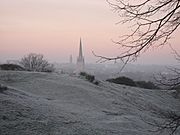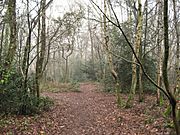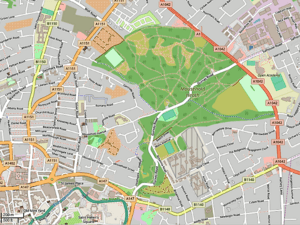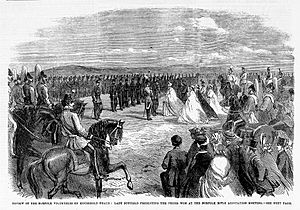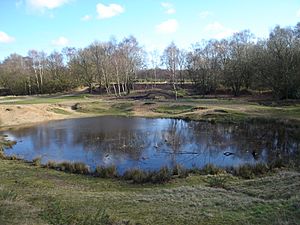Mousehold Heath facts for kids
Mousehold Heath is a special place with open heathland and woods. It's located just northeast of Norwich, a historic city in eastern England.
Long ago, Mousehold Heath was much bigger. It stretched almost to an area called the Broads. Back then, animals grazing and people cutting trees kept it mostly clear of tall trees. But over time, things changed. In the 1800s, much of this land was divided up and fenced off. It became farmland, parks, or new parts of Norwich with roads, shops, and houses. The Mousehold Heath we see today is smaller. It has mostly broad-leaf trees and some managed heathland. It's also home to many interesting and rare insects, birds, and other animals.
A small chapel was built on the heath for William of Norwich, a local child who died in 1144. Not much of it remains today. In 1549, Robert Kett and his followers camped here before their big rebellion was stopped. In the past, people used the heath to gather fuel, food, and building materials. They also dug for sand, clay, and gravel. Parts of the heath were even used for cavalry training, horse races, an airfield, and a prisoner-of-war camp. Today, the last part of the original Mousehold Heath is looked after by Norwich City Council. It is surrounded by homes and businesses.
Contents
What is Mousehold Heath Like?
Mousehold Heath is a public area covering about 184 acres. It has heathland, woodland, and open spaces for fun activities. It's the biggest nature reserve managed by Norwich City Council. This area was once a huge heath that stretched far to the north and east of Norwich. Over the years, much of it became woods, farms, or new housing areas.
The landscape of Mousehold Heath was shaped by ancient rivers. These rivers created a flat area with lots of sand and gravel. The ground here has many layers of glacial deposits from a very cold period. These layers sit on top of older Cretaceous chalk rock.
The chalk formed about 75 million years ago when this area was a warm, tropical sea. You can still see this chalk today at St James' Pit, a special geological site. About two million years ago, sand, gravel, and clay were laid down across Norfolk, including the heath. More layers of clay, sand, and gravel were added about 425,000 years ago by melting ice. The heath's current shape was formed by erosion from streams cutting through soft rocks. Later, silt was blown over the topsoil, and the ground shifted due to temperature changes.
Norwich City Council has created a 'Heritage Trail' leaflet. It gives detailed information about the geological history of Mousehold Heath.
What Does the Name "Mousehold" Mean?
People have different ideas about where the name Mousehold Heath came from. The old name, Mushold, is now thought to mean 'mouse wood'. Some believed it came from the Anglo-Saxon words moch-holt, meaning 'thick wood'. In 1819, John Stacy suggested it might come from Moss-wold ('mossy hill'). He also thought it could be Monks-hold, meaning 'owned by the monks'.
Mousehold Heath Through History
Medieval Times: Early History
Large areas of heathland grew across Norfolk towards the end of the prehistoric period. After the Romans left, much of it turned back into woodland. But as more people arrived, it became heath again. The Domesday Book shows that Mousehold Heath was still quite wooded. However, people cut down more trees for fuel, and it became mostly treeless. Animals grazing and human activities kept it this way. Some parts were even ploughed into fields called 'brecks'. The name Mousehold first referred to the 'holt' or wood that was there before it became heathland.
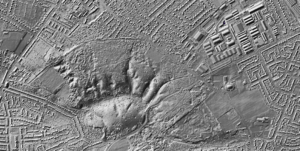
St. Leonard's Priory was built on the heath around 1094. It was a temporary home for the monks of the unfinished Norwich Cathedral. It also helped the Normans control a nearby chapel. The priory was taken down in 1538, and nothing of it remains above ground today.
In 1144, the body of a young apprentice named William of Norwich was found on the heath. A false story spread that his death was a 'ritual murder' by local Jewish people. This was the first time such a false accusation, known as blood libel, happened in Europe. The sheriff of Norwich bravely protected the innocent Jewish community from harm. William later became known as a saint. A chapel, first for St. Catherine, was built where his body was supposedly found. In 1168, it was renamed the chapel of St. William in the Wood. People continued to leave offerings there until 1506. The overgrown remains of this site are on the northern edge of the current heath.
In 1381, a big meeting for the Peasants' Revolt happened on the heath on June 17. Geoffrey Litster was declared "King of the Commons" here. The final battle of the revolt took place a few days later.
1500-1810: Changes to the Heath
During the Tudor period, the heath was mostly treeless and open countryside. It stretched from Norwich all the way to the Broads. Local people could freely collect wood and let their animals graze there.
Small villages were located around the heath. Salhouse, a farming village, was one example. It had a small settlement on higher, well-drained heathland. It also had a mix of woods, marsh, and meadows on lower ground. Old place names like Mouseholdheath Farm show how close the heath was to Salhouse.
Kett's Rebellion started on July 12, 1549. It began as a protest about land being fenced off. It grew into a large uprising led by Robert Kett, a local landowner. The rebels took control of Norwich, which was then the largest English city outside London. They held the city for over a month, camping on Mousehold Heath. After asking the authorities for fairer treatment, they defeated an army sent by the Marquis of Northampton. However, a much larger government army, led by John Dudley, took back Norwich. The rebels had to leave their camp. The rebellion was stopped six weeks after it began. About three thousand rebels were killed in a big battle, possibly at a place called 'Dussindale'.
Enclosing the Land
Until the early 1800s, Mousehold Heath still reached Woodbastwick. You can see this on Faden's 1797 map of Norfolk. It was a wide-open space with many paths and lanes. The heath was a big part of the countryside east of Norwich, and everyone could use it. But some landowners and city officials wanted to develop this large area of unused land. In 1783, there was an idea to turn part of the heath near the city into a burial ground, but this was dropped. In 1792, there was a plan to make a large part of the heath into "pleasurable grounds." Landowners with big country houses around the heath pushed for the area to be fenced off. Rackheath’s common land was the first to be enclosed in 1799, making Rackheath Park bigger.
Between 1799 and 1810, the entire heath was turned into farmland and pastures. This happened because of special laws called Inclosure Acts. This process created long, straight roads and new farms. The needs of local people were not considered much. Many became poor because they could no longer use the land. Parks around large houses, like at Sprowston and Rackheath, grew bigger. New views were created for their owners by removing old woods and planting new lines of trees.
1810-1914: Art, People, and Industry
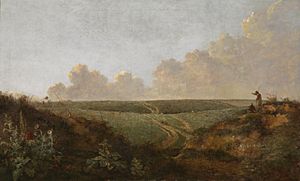
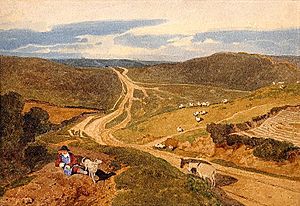
Mousehold Heath became famous because many artists from the Norwich School of painters painted it. These included John Crome and John Sell Cotman, as well as John Constable. They found heathland landscapes interesting and painted them often. This was true even though farmers thought such landscapes were useless. The Norwich School's paintings of Mousehold Heath usually don't show people, animals, or growing crops. Because Norfolk was far away, few artists from outside the county painted the heath. Many artists at the time preferred to paint ideal landscapes: lush, peaceful farming countryside with woods. This was very different from the wild, empty environment of a heath like Mousehold. The Norwich School artists saw the heath being destroyed after it was enclosed. Their paintings would have brought back memories of a lost landscape.
In his book Lavengro, George Borrow wrote about meeting gypsies on the heath. The Norwich-born novelist and former Lord Mayor, R. H. Mottram, also loved the open space of Mousehold Heath. He once said it was "the property of those who have the privilege of Norwich birth."
Public horse racing near Norwich started in 1838. Within a few years, races were held on a track on Mousehold Heath.
Before the 1900s, the heath was used to dig for sand and gravel. Victorian maps show there were lime kilns, marl pits, and brick kilns. There were also many large gravel pits on the unenclosed part of the heath. You can still find the remains of these diggings today.
During much of the 1800s, the people of Pockthorpe, a place between Norwich's city walls and the heath, were quite free from the control of local factory owners. They could use Mousehold to graze their animals and collect food, fuel, and materials for brick-making. This community of weavers, shopkeepers, and labourers (and even smugglers) largely managed itself. Local magistrates and Norwich Cathedral officials were more focused on city matters. The people of Pockthorpe even made fun of the authorities. For example, they elected their own ‘mayor’ and started the Pockthorpe Guild in 1772. In 1844, they began a campaign to take full control over Mousehold Heath. They tried to make outsiders pay a fee to take materials from the land and hire Pockthorpe men to work on the heath. The Guild helped the poor but was unfair to people in nearby communities. This 25-year campaign failed, even with some support from Norwich politicians. The local people then started acting badly towards the newly created park. They tore down notice boards, had disputes, played games for money in public, and spent time with the local soldiers.
The ownership of the remaining heathland was given to the city in 1880. The Church of England donated the land to the Corporation of Norwich. They did this to stop "trespasses, nuisances, and unlawful acts." They wanted the heath to be used for "lawful recreation." The Pockthorpe committee was defeated. The people of Pockthorpe now had to follow strict rules. They could no longer use the heath to support themselves. Because of this change, the unmanaged part of the heath was no longer grazed, and it turned back into woodland.
Despite strong local resistance, the 1884 Mousehold Heath Confirmation Act became law. It set up 'conservators' to manage the remaining part of the heath. Today, Norwich City Council and the Mousehold Heath Conservators manage it.
The Britannia Barracks were built on Mousehold Heath for the Norfolk Regiment. After a battle in 1707, the regiment was allowed to wear a figure of Britannia on their uniforms. The new infantry barracks were named after this figure. The main buildings were built between 1887 and 1897. The regiment left the barracks in 1959. Most of the buildings later became part of Norwich Prison.
During the Second World War, a prisoner-of-war camp for German workers was set up near the old airport. Its exact location is still being confirmed.
On February 12, 1942, a Hampden bomber plane crashed on Mousehold Heath. The pilot died while trying to reach another airfield. On July 25 of the same year, a Bristol Beaufort plane also crashed on the heath.
Mousehold Heath Airfield
In October 1914, an old cavalry training ground on the heath was taken over by the Royal Flying Corps. It was turned into an aerodrome, which is an early type of airport. Several local companies used it for making aircraft, including Boulton & Paul. This company hired up to 3000 people in Norwich to assemble aircraft. Many of these workers were women who were trained in basic engineering skills. From October 1915, Boulton & Paul built over 2,500 aircraft.
In 1918, the Norwich Electric Tramways service was extended to the aerodrome. This helped transport equipment and materials between Norwich railway station and the airfield. The Norfolk & Norwich Aero Club was formed at Mousehold in 1927. From 1933 until the start of the Second World War, this aerodrome was the first Norwich Airport. It had four grass landing strips.
The airfield was used until around 1950. Much of the old aerodrome was later built over when the Heartsease housing estate was created. However, some of the airfield buildings still exist today within the Roundtree Way industrial estate.
Mousehold Heath Today
Today, the remaining 184 acres of Mousehold Heath have many tracks and paths. There are two football pitches, a pitch and putt course, a restaurant, a bandstand, and several parking areas. Many events are held here, including concerts, guided walks, conservation projects, football matches, and fundraising events. A single road, Gurney Road, goes through the middle of the heath. The original Ranger's house has been bought for renovation.
Vinegar Pond was created by quarrying and later by wartime activities. It's an important place for breeding frogs. It gets its water from rain, so it can dry out when the weather is hot. Pictures from 1946 show the pond was there then, but it doesn't appear on older maps.
In 1984, a new Mousehold Heath Act became law. In 1992, the bandstand near the football ground was rebuilt. This was done by the Mousehold Defenders using money raised locally.
Harrison's Wood, covering 67 acres, was once part of the heath before it was fenced off and turned into a tree plantation. It was opened to the public in May 2016. It is located within the White House Farm housing development.
In early 2019, a draft of the new Mousehold Heath Management Plan was shared online. This plan aims to make Mousehold Heath safer and cleaner. It also aims to protect the heath's historic features and buildings.
Wildlife on the Heath
Mousehold Heath is a special place for nature. It is a designated Local Nature Reserve and a County Wildlife Site.
In recent years, conservation work has started. The goal is to improve the existing heathland and bring back areas that have become woodland. This helps protect many rare species that live on the heath. Since animals can't graze to clear the growing woodland, Mousehold Heath Wardens, volunteers, and contractors clear the trees. They also remove humus (decayed plant matter). This helps heather plants grow back from their seeds. Gorse, broom, and young trees are removed. Volunteers also 'bruise' the bracken with sticks to reduce its growth in future years.
Many different animals with backbones live on Mousehold Heath. Amphibians include the common frog and the common toad. Reptiles include the grass snake, the common lizard, and the slowworm. Mammals on the heath include muntjac and roe deer, red fox, rabbits, and various small rodents. Besides common urban birds, the heath is home to breeding sparrowhawks and tawny owls. You can also find nuthatches, treecreepers, and great spotted woodpeckers.
The heath is rich in invertebrates (animals without backbones). It is home to many rare butterflies, bees, and other insects. Some species found here are the ruby-tailed wasp, digger wasp, Green Hairstreak butterfly, mottled grasshopper, and tiger green beetle.
Heathland plants found on Mousehold Heath include Sheep's Sorrel, bracken, Wavy Hair-grass, Mossy Stonecrop, Trailing St John's-wort, Common Cudweed, and Viper's Bugloss.


